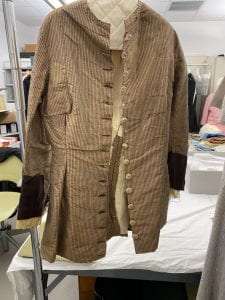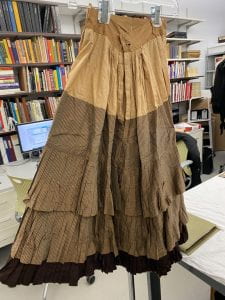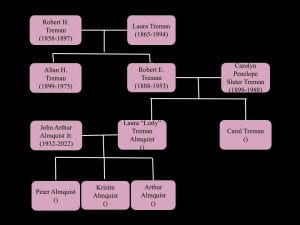Blog post by Isabel Schorn
This online blog post features materials protected by the Fair Use guidelines of Section 107 of the US Copyright Act. All rights reserved to the copyright owners.
While browsing through the Cornell Fashion and Textile Collection database, I stumbled across a blurry image of a young girl and boy dressed head-to-toe in Late Victorian-era clothing. All I knew was the donor, Laura Treman Almquist, and the date of manufacture, 1885. I decided to take on the seemingly simple task of identifying the girl in the picture. I wanted to know who she was, and how the intricately handmade garment was created just for her.
The outer textile of the garment are a woven silk, a compound weave with shades dark brown, taupe, and white. The lining on the tunic is a thick cotton muslin. It is fit for a 10-year-old girl with darts at the waistline of the tunic. All the buttonholes are hand-sewn. The silky outer surface is disrupted by prominent signs of wear. This includes substantial tears at the underarm and waist, places where garments tend to move a lot. Protruding weft fibers spill out at these orifices to reveal the plain muslin underneath.
They are a signal of both age and wear, demonstrating that the garments were worn repeatedly many years ago. The skirt is lined with a fine burlap gathered by hand stitches to accentuate the form of the garment. The bottom tier of the skirt is pleated to add form without the bulk of gathered fabric. The waistband and the first tier of the skirt are a different fabric than the woven silk of the rest of the set. This is likely an attempt to save money by using a cheaper material than woven silk. It is covered by the tunic when the set is worn together, and using a cheaper fabric is a more economical way of production.
The Treman family was an influential Ithacan dynasty during the 19th and 20th centuries. They profited from Ithaca’s growing infrastructure and industry while quickly acquiring land throughout the Finger Lakes region (Palmyra, 2013). Robert H. Treman was trustee of Cornell University when he married his wife Laura Hosie Treman in the early 1880s. The couple then had Allan H. Treman and Robert E. Treman over the next two decades (“Guide to …,” n.d.). Robert E. Treman traveled the world with his first wife and “it” woman of the time, Irene Castle, until he returned to Ithaca in the 1930s. He then settled down and married his second wife, Carolyn Slater Treman, in 1934. The couple had two children, Laura “Lolly” Treman and Carol Treman, and lived in Ithaca until Robert E. Treman’s untimely death in 1953 (“Robert Elias Treman,” n.d.). Yet, according to a 2013 article on Ithaca.com (Palmyra, 2013), there are no remaining Tremans in Ithaca anymore, which made speaking with someone in person to identify the owner of this outfit exceedingly difficult. Through other primary sources, which included an unsettling number of obituaries, I was able to construct a family tree of the Treman family from Laura Hosie Treman to Kristin Almquist, daughter of Laura “Lolly” Treman Almquist who donated the ensemble.
One summer day in 1956, wearing a notably gorgeous lacy gown, Lolly married John Arthur Almquist, a military man and fellow Cornell alumnus (Buzzell, 1956). The couple moved to Tucson, Arizona where they lived together until John’s untimely death last March. Lolly still lives in Tucson along with her three children (“John Arthur Almquist Jr.,” 2022). In 1997, she mailed an organized package of Treman family clothing to the Cornell Fashion and Textile Collection to be archived. Somewhere in that package sat the tunic and skirt, waiting to be unearthed and analyzed.
I hypothesize that this set was a family heirloom, that it was made by a grandmother as a young woman, then passed on to the granddaughter. In the donor file, I found another image, a clearer, more modern one of a young girl on a horse wearing the ensemble. The bottom left corner reads “Dress: Laura Hosie Treman.” Laura Hosie Treman likely created this dress by hand, though exactly who she created it for remains a mystery.
The only image of the ensemble on the Cornell Fashion and Textile Collection database is of two children I have been unable to identify. I assume that it was from 1885 at the creation of the set. Although Laura Hosie Treman created the garments, she would likely have been too old to be the girl in the image. Maybe it was a friend, or another distant Treman relative.
The name “Carol Treman, age 10” appears in the bottom right corner of the other image, the one from the donor file. This was immediately puzzling. Although I could not find an exact birthdate for Carol, I knew that she was a high school student in 1953 (“Robert Elias Treman,” n.d.). It would have been impossible for her to have been 10 years old in 1885 when the garment was first created. Could it be a photograph of Carol playing dress-up in the 1940s?
This garment was passed through generations of Tremans, meaning that it was worn by young people in times with different expectations about what a child should wear. Even so, western society was persistent in one value up until the 1950s: that children should look and behave like miniature adults (Peacock, 2009). Societal values about childhood are apparent through the way children are expected to dress. In this outfit particularly, modesty and formality come to mind. It was created in the Late Victorian era, a time of bustles and trains that lengthened and formed the female body. This outfit is similar. It extends all the way to the girl’s ankles and cinches in her waist. Although some bustles were made for children, it is unclear if the girl is wearing one in the first photo. As indicated by the golf club in the image, it was something to be worn while being active, yet the stiff material and delicate appliques indicate otherwise. It would be incredibly difficult for a child to move around in such a garment.
In modern times, childrenswear is designed and created very differently. In some cases, children are still dressed like adults, yet the priority seems to be comfort rather than modesty or formality. As the 20th century progressed, the focus of childrenswear shifted from valuing what parents wanted their children to look like to valuing what supports the needs and wants of an active, growing child (Scott, 2004). Additions of elastic waistbands and associations of childhood with bright colors created stark differences between kids and adult apparel. Today children’s clothing is an entirely separate industry. It values the distinction between children and adults and empowers young people with more choice in what they wear. It is vital then to wonder whether the girl in the original image felt empowered by the outfit, or whether she was confined by the same body and modesty standards as the adult women around her.
References
Buzzell, G.C. (1956, July 15). Miss Laura Treman Married in Ithaca To Ensign John A. Almquist Jr. of Navy. The New York Times, p. 58. Cornell University Library.
Guide to the Treman Family Collection. (n.d.). The History Center. Cornell University Library.
John Arthur Almquist Jr. (2022, March 29). AzCentral. https://www.azcentral.com/obituaries/par059005
Palmyra, C. (2013, January 16). Treman Family Guided Region Toward the Future For Two Centuries. Ithaca.com. https://www.ithaca.com/special_sections/treman-family-guided-region-toward-the-future-for-two-centuries/article_dcc4500e-6025-11e2-bb45-0019bb2963f4.html
Peacock, J. (2009). Children’s Costume: The Complete Historical Sourcebook (p. 7). : Thames & Hudson.
Robert Elias Treman. (n.d.). Find a Grave. https://www.findagrave.com/memorial/164099908/robert-elias-treman
Scott, W. R. (2004, February). The Commodification of Childhood: The Children’s Clothing Industry and the Rise of the Child Consumer. History: Reviews of New Books, 33(1), 13. Cornell University Library.





